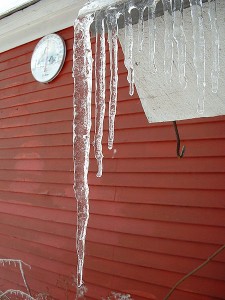 During winter time it is not uncommon that snow on a roof is melted by the sun or the heating of the house below. The produced melt water will run off the roof and form something familiar to most of us: Icicles, vertical spikes of ice hanging from roofs. They are such an iconic symbol of winter that they found their way into manychristmas decorations or greeting cards.
During winter time it is not uncommon that snow on a roof is melted by the sun or the heating of the house below. The produced melt water will run off the roof and form something familiar to most of us: Icicles, vertical spikes of ice hanging from roofs. They are such an iconic symbol of winter that they found their way into manychristmas decorations or greeting cards.
But how can one describe the shape and growth process of icicles in detail? A strange question at first glance, but considering that icicles can cause considerable damage when forming on power lines or airplane wings it seems worth asking.
Unfortunately the growth process is not yet fully understood. A theory that predicted self similar shapes for icicles [1] has recently been investigated in experiments.[2] These experiments show that the theory has severe limitations (e.g. it does not include tip splitting) and the theoretical predictions can only be reproduced under some environmental conditions but not others. Even stranger, the agreement between theory and experiment gets better the more the experimental conditions deviate from theoretical assumptions.
Clearly a lot more has to be understood about the growth and morphology of icicles.onmental conditions but not others. Even stranger the agreement between theory and experiment gets better the more the experimental conditions deviate from theoretical assumptions.
Stephan Koehler
Read more:
[1] Short, Baygents, and Goldstein, Phys. Fluids 18, 083101 (2006).
[2] Chen and Morris, Physical Review E 83, 026307 (2011)